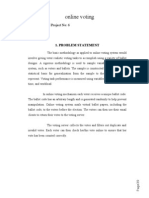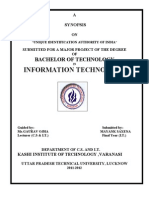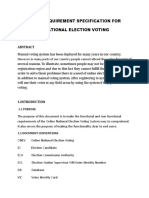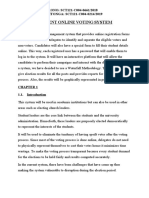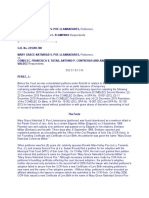Online Smart Voting System Using Face Recognition
Online Smart Voting System Using Face Recognition
Volume 8, Issue 3, March – 2023 International Journal of Innovative Science and Research Technology
ISSN No:-2456-2165
Online Smart Voting System using Face Recognition
S. Ashok Kumar
Assistant Professor: Department of InformationTechnology
SRM Valliammai Engineering College
Chennai, India
A. Muhammad Marzooq U. Ranjithkumar
Department of Information Technology Department of Information Technology
SRM Valliammai Engineering College SRM Valliammai Engineering College
Chennai, India Chennai, India
S. Romario P. Surya
Department of Information Technology Department of Information Technology
SRM Valliammai Engineering College SRM Valliammai Engineering College
Chennai, India Chennai, India
Abstract:- An online voting system using face recognition (Lok Janshakti Party) Chief, Ram Vilas Paswan saying
is a digital platform designed to enhance the security and that Bihar election were having 30% fake voter- cards.
accuracy of the voting process. The system utilizes facial Electioninvolves both public or private vote which depends
recognition technology to verify the identity of voters, on theposition. Local, state, and federal governments are some
ensuring that only eligible voters can participate in the ofthe most important positions. In paper based on election,
election. This system eliminates the need for physical Voters cast their votes by simply depositing their ballots in
polling stations, reducing costs and increasing accessibility sealed boxes distributed across the electoral circuits arounda
for voters. The abstract of this system would detail its given country. After ending of election period, the boxes
features, including its ability to authenticate voter which contains of ballot control unit are opened and votes are
identities, securely store votes, and prevent fraud. It would counted manually in presence of the certified officials
also discuss the benefits of using such a system, such as appointed by election commission.
increased voter turnout and improved transparency in the
electoral process. Object Detection using Haar feature- So, it is a time-consuming process and requires alot of
based cascade classifiers is an effective object detection resources to conduct voting process. In this paper we have
method. Local Binary Pattern (LBP) is a simple yet very proposed online voting system to cast the vote using face
efficient texture operator which labels the pixels of an recognition. The information about the Face is passed to the
image. Then the server checks for the data from the server unit for the further verification. Then the server checks
database and compares that data which is already existing for the data from the database and compares that data which
in database. If the data matches with the already stored is already existing in database.
information, the person is allowed to poll the vote. If not, a
message is displayed on the screen and therefore the If the data matches with the already stored information,
person is not allowed to poll the vote. Overall, an online the person is allowed to poll the vote. If not, a message is
voting system using face recognition technology has the displayed on the screen and therefore the person is not
potential to revolutionize the way we conduct elections, allowed to poll the vote. For voting representatives are
making the process more efficient, secure, and accessible appointed by electorates. In current scenario voter needs to
for all. show his/her voter ID card to cast the vote on thebooth. So,
this process is time consuming as the voter ID card needs to
Keywords:- Face Recognition, Haar Cascade, LBPH, User be get verified by the officials.
Authentication.
Thus, to speed up the voting process and avoid such type
I. INTRODUCTION of problems, we have proposed the new system.
As per the records of TOI 24 Jan 2009 11 lakhs fakevotes II. LITERATURE SURVEY
were observed in Delhi. Then according to India News June
2013: 30000 illegal voters were found in election commission As per the bylaw of the Constitution of India, the
under Sheila Dikshit constituency. Another news which was Election Commission of India (ECI) has been driven to
alleged by LJP. conduct elections honestly and autonomously at regular
intervals. For this, from the last decade onwards they are
implementing advanced technologies in the election process
IJISRT23MAR742 www.ijisrt.com 1129
Volume 8, Issue 3, March – 2023 International Journal of Innovative Science and Research Technology
ISSN No:-2456-2165
to ensure efficacy, less time consumption, and cost. Right now, will be verified via One Time Password (OTP). After voter
the ECI effectively utilizing the Voter-VerifiedPaper Audit verification, individual voters will be considered eligible for
Trail (VVPAT) with an Electronic VotingMachine (EVM) to voting. During voting, voters will be monitored through a
ensure each individual votes. However, still, the ECI webcam/front camera. The votes will be stored in a
struggling to control malpractice that exists in the election blockchain and any tampering would be detected easily. The
process while verifying voters with an electoral list. To address and the corresponding constituency will be checked
overcome these issues, a face recognition device is embedded in the backend. Voting results will be declared on a specified
with the EVM. The ECI trying to achieve a morethan ninety- date and will be handled bythe admin. The results will be
five percent polling rate in a democratic country. At present, displayed graphically with various options to choose from
the average polling rate in all types of elections has not and will also include past results and statistics [4]. India has
reached a mere seventy percent. The ECI is unable to achieve only offline votingsystem which is not effective and upto the
its target due to people migrating from state to state and mark as it requires large man force and it also requires more
abroad for employment [1]. The electoral system is the time to process and publish the results. Therefore, to be made
backbone of democracy and organization. The electoral effective, the system needs a change, which overcomes these
system has experienced many efficient changes within the disadvantages. The new method does not force the person's
past few decades. India being a majority rule government, the physical appearance to vote, which makes the things easier.
world's biggest, still directs its races utilizing either Secret This paper focuses on a system where the user can vote
Ballet Voting (SBV) or Electronic Voting Machines (EVM), remotely from anywhere using his/her computer or mobile
the two of which include significant expenses, physical work phone and doesn't require the voter togo to the polling station
and are wasteful. In the existing system, it verified only through two step authentication offace recognition and OTP
identification proof, which made more chances for fake system. This project also allows the user to vote offline as well
voting. To avoid the above issues, we developed a web- if he/she feels that is comfortable. The face scanning system
based smart voting system along with novel face detection is used to record the voters face prior to the election and is
and recognition approach. The entire online framework useful at the time of voting. The offline voting system is
empowers individuals to protect their votes from any place on improvised with thehelp of RFID tags instead of voter id. This
the planet. Utilizing the ID of appearances lessens the shot at system also enables the user the citizens to see the results
copying a vote andthe individuals who are enlisted advance to anytime which can avoid situations that pave way to vote
the political race and are perceived by the framework will be tampering[5]. The citizens can cast their vote either through
permitted to cast a ballot. Accordingly, the methodology ballet paper or Electronic Voting Machine [EVM]. Using
makes the framework the most ideal approach to make the either way of voting has a chance to misuse the other votes.
choice [2].Web-based system enables voter to cast their votes As aresult, this research work proposes a fingerprint sensor
from anywhere in the world. Online website has a prevented and vote caster fingerprints will be taken and it will be
IP address generated by the government of India for election extracted and saved in the database for the voter registration
purpose. People should register the name and address in the and authentication processes. Storing the information in the
website. Election commission will collect the fingerprint and database will prevent more than one registration from a single
face image from the voters. The database or server willstore person. At the time of voting or during voting day, the
the images. When the images are obtained on the casting day, individual person need to scanhis/her fingerprint and it will
it will be compared with database and provides a secured be compared with the fingerprint database if the fingerprint is
voting on the Election Day. System utilizes faces and found in the fingerprint database. By using the Voter identity
fingerprints to unlock the voting system, similar to themobile number and fingerprint, numerous duplicate registrations can
phone are used. The current system requires the physical be stopped and this will lead to high rate of actual success
presence of voter, which is inconvenient to many voters. The during voting. Voters can cast their ballots from any part if
process consumes less time as well. Using the detection of world by using their voter's unique identifier, authentication
face and fingerprint images, the number of fake voters can be responses given on enrollment, and a token key supplied
reduced. The eyes and eyebrows distance remains constant immediately for every member via the specially designed
with growing age to make the system more secure. This election web module. The administrator will send the token to
research work utilizes ten print image to detect the correct the linked candidate's Email address. This proposed project
name of voter [3]. Blockchain is used to store data which is has been implemented [6].
near impossible to change or tamper with as it is very secure
in nature. Voting as a process in any nation is an essential III. METHODOLOGY
event and if votes get miscalculated by any external source it
will be harmful. Toavoid such kinds of situations and making A. Open CV
it more comfortable blockchain technology comes in OpenCV-Python open-source library, which isused for
acknowledgment. This paper proposes a decentralized computer vision in Artificial intelligence, Machine Learning,
national e-voting system based on blockchain technology. It face recognition, etc.
includes an admin panel to schedule the voting, manage
candidates and declare the results. The web application will B. Haar Cascade
provide the users with an interface to enter their Aadhaar card Object Detection using Haar feature-based cascade
ID (text input) and a photo of themselves at the time of voting. classifiers is an effective object detection method. It is a
The eligibility of the voter will be checked at the time they machine learning based approach where a cascade functionis
enter their Aadhaar card ID. Eligible voter's phone numbers trained from a lot of positive and negative images. It is then
IJISRT23MAR742 www.ijisrt.com 1130
Volume 8, Issue 3, March – 2023 International Journal of Innovative Science and Research Technology
ISSN No:-2456-2165
used to detect objects in other images. Each feature isa single Fig.2 uses username & password or other forms of
value obtained by subtracting sum of pixels under the white authentication to ensure that only authorized administrators
rectangle from sum of pixels under the black rectangle. can access the admin interface.
F(Haar)=∑ F white-∑ F black
∑ F white = Sum of pixels of bright area
∑ F black = Sum of pixels of dark area F(Haar) = the Haar-
like feature
C. LBPH Algorithm
Local Binary Pattern (LBP) is a simple yet very efficient
texture operator which labels the pixels of an image by
thresholding the neighborhood of each pixel andconsiders the
result as a binary number. Then convert this binary value to a
decimal value and set it to the central value of the matrix,
which is a pixel from the original LBP operator considers a
3 × 3 patch, so the surrounding pixels form a binary number
of 8 digits. After all the pixelsin an image are labeled, LBP
feature map, and a histogram that consists of 256 bins is
obtained. The LBP histogram can be used as a feature vector Fig. 3: Block Diagram
for classification where each bin represents one feature.
Fig.3 shows the different components of online smart
LBP P,R (xc,yc) = p-0∑P−1s(gp−gc)2p voting system work together to provide user friendly voting
experience.
IV. OUTPUT RESULTS
Initially, user needs to register in the system by
providing information such as Aadhaar number, Mobile
number, City, Age, Password etc. This information is storedin
voter dataset. The system takes input image from the userat the
time of registration through webcam. This image is stored in
face dataset for template matching. Then for casting the vote,
user needs to login to the system by entering Aadhaar number
and Password.
We must have a very good quality camera to get the
efficient detection and recognition. It will capture the video.
The video into convert the multiple frames. It will helpful for
more accurate to produce the results. Facial recognition is a
way of identifying or confirming an individual's identity
Fig. 1: User Module Architecture
using their face. Facial recognition systems can be used to
identify people in photos, videos, or in real-time. Facial
Fig.1 uses face recognition to verify user’s identity
recognition is a category of biometric security.
based on their facial features.
Fig. 2: Admin Module Architecture Fig. 4: User Registration
IJISRT23MAR742 www.ijisrt.com 1131
Volume 8, Issue 3, March – 2023 International Journal of Innovative Science and Research Technology
ISSN No:-2456-2165
The primary function of Fig.4 is to manage the V. CONCLUSION
registration of eligible voters for the upcoming election.
At present our government is spending more than 125
crores for conducting a Lok Sabha election. This money is
spent on issues such as security, electoral ballots etc. The
average percentage of voting is a less than 60%. Moreover,
voting fraud can be easily done in the present system. Also,
the percentage of literates coming to vote is very less. But
with our system the money spent on election can be reduced
to less than 10 crores. Also, there is no chance of voter frauds
and the money spent on security can be drastically decreased.
Persons who have an internet connection at home with a web
camera can vote without taking the strain to come to voting
booths. the implementation of an online voting system using
facial recognition technology has the potential to increase
accessibility, convenience, and security in the electoral
process. The use of facial recognition technology can help to
verify the identity of voters, prevent fraudulent activities, and
provide a seamless voting experience. However, it is
important to ensure that the system is designed and
Fig. 5: Verification Code in Email implemented in a way that guarantees the privacy and
security of voters' personal information and prevents any
potential bias or discrimination. Additionally, it is crucial to
provide alternative options for individuals who may not have
access to or may not be comfortable with using facial
recognition technology. Overall, while an online voting
system using facial recognition has the potential to improved.
VI. FUTURE WORK
The future scope for an online voting system usingfacial
recognition technology is vast and exciting. As facial
recognition technology continues to advance, we can expect
higher accuracy rates and improved reliability in verifying the
identity of voters. This will help to ensure the integrity of the
voting process. Blockchain technology can help to provide a
secure and transparent voting process. By integrating
blockchain with facial recognition technology, we can create
Fig. 6: Email Authentication a tamper-proof voting system that ensures the accuracy and
transparency of the results. User experience isa critical factor
in the success of an online voting system. Future
advancements in the design and user interface can help to
make the process more user-friendly and intuitive. The use of
facial recognition technology can extend beyondthe electoral
process. It can be used in various sectors like banking,
healthcare, and education, to verify the identity ofindividuals
and improve security. Overall, the future of online voting
systems using facial recognition technology is promising, and
we can expect to see further developmentand integration of
this technology in the coming years.
REFERENCES
[1]. K. Patidar and S. Jain, "Decentralized E-Voting Portal
Using Blockchain," 2019 10th International Conference
on Computing, Communication and Networking
Technologies (ICCCNT), 2019, pp. 1-4.
Fig.7: Face Recognition for Authentication [2]. S. S. Kadam, R. N. Choudhary, S. Dandekar, D. Bardhan
and N. B. Vaidya, "Electronic Voting Machine with
Enhanced Security," 2018 3rd International Conference
on Communication and Electronics Systems (ICCES),
IJISRT23MAR742 www.ijisrt.com 1132
Volume 8, Issue 3, March – 2023 International Journal of Innovative Science and Research Technology
ISSN No:-2456-2165
2018, pp. 403-406.
[3]. R. Rezwan, H. Ahmed, M. R. N. Biplob, S. M. Shuvoand
M. A. Rahman, "Biometrically secured electronicvoting
machine," 2017 IEEE Region 10 Humanitarian
Technology Conference (R10-HTC), 2017, pp. 510-
512.
[4]. Z. A. Usmani, K. Patanwala, M. Panigrahi and A. Nair,
"Multi-purpose platform independent online voting
system," 2017 International Conference on Innovations
in Information, Embedded andCommunication Systems
(ICIIECS), 2017, pp. 1-5.
[5]. K. H. S, B. G. B, H. M. P, A. D. L and A. V, "Secured
And Transparent Voting System Using BiometricAnd
Face Recognition," 2021 International Conference on
Design Innovations for 3Cs Compute Communicate
Control (ICDI3C), 2021, pp. 254-259.A. A. Mandavkar
and R. V. Agawane, "Mobile based facial recognition
using OTP verification for voting system," 2015 IEEE
International Advance Computing Conference (IACC),
2015, pp. 644-649.
[6]. S. Wattamwar, R. Mate, P. Rainchwar, S. Mantri and G.
Sorate, "Optimal Face Recognition System using Haar
Classifier," 2021 International Conference on Smart
Generation Computing, Communication and
Networking (SMART GENCON), 2021, pp. 1-7.
[7]. M. Kandan, K. D. Devi, K. D. N. Sri, N. Ramya and N.
K. Vamsi, "Smart Voting System using Face Detection
and Recognition Algorithms," 2021 IEEE International
Conference on Intelligent Systems, Smart and Green
Technologies (ICISSGT), 2021, pp. 202-206.
[8]. S. Ganesh Prabhu, A. Nizarahammed., S. Prabu., S.
Raghul., R. R. Thirrunavukkarasu and P. Jayarajan,
"Smart Online Voting System," 2021 7th International
Conference on Advanced Computing and
Communication Systems(ICACCS), 2021, pp. 632-634.
[9]. N. Bhuvaneswary, C. V. Reddy, C. Aravind and K. H.
Prasad, "Smart Voting Machine using Fingerprint
Sensor and Face Recognition," 2022 International
Conference on Applied Artificial Intelligence and
Computing (ICAAIC), 2022, pp. 1159-1166.
[10]. S. L. Rikwith, D. Saiteja and R. Jayaraman,
"Enhancement of Electronic Voting Machine
Performance Using Fingerprint and Face Recognition,"
2021 2nd InternationalConference on Smart Electronics
and Communication (ICOSEC), 2021, pp. 757-763.
[11]. H. V. Purandare, A. R. Saini, F. D. Pereira, B. Mathew
and P. S. Patil, "Application For Online Voting
System Using Android Device," 2018 International
Conference on Smart City and Emerging
Technology (ICSCET), 2018, pp. 1-5.
IJISRT23MAR742 www.ijisrt.com 1133
You might also like
- Fingerprint Based Biometric Voting Machine Using Arduino PDF100% (1)Fingerprint Based Biometric Voting Machine Using Arduino PDF18 pages
- Online Voting System Project Proposal ReportNo ratings yetOnline Voting System Project Proposal Report7 pages
- Attachment A - Dominion D-Suite 5.5-A Implementation StatementNo ratings yetAttachment A - Dominion D-Suite 5.5-A Implementation Statement57 pages
- The Role of Lawyers in Election Cases: AbstractNo ratings yetThe Role of Lawyers in Election Cases: Abstract6 pages
- Model By-Laws For Primary Cooperatives in The Philippines100% (41)Model By-Laws For Primary Cooperatives in The Philippines20 pages
- Smart Voting System Using Facial RecognitionNo ratings yetSmart Voting System Using Facial Recognition8 pages
- An Online Voting System Using Biometric Fingerprint and Aadhaar CardNo ratings yetAn Online Voting System Using Biometric Fingerprint and Aadhaar Card6 pages
- Design and Implementation of Electronic Voting System (Online Web Based)No ratings yetDesign and Implementation of Electronic Voting System (Online Web Based)24 pages
- Project Report On E-Polling System Using PythonNo ratings yetProject Report On E-Polling System Using Python31 pages
- Palak Srivastava - Documentation (Online Voting System) PDFNo ratings yetPalak Srivastava - Documentation (Online Voting System) PDF25 pages
- Oting Ystem: Submitted By: Vishal Patel Jigar Panchal100% (1)Oting Ystem: Submitted By: Vishal Patel Jigar Panchal13 pages
- Project Report: "Project On Online Voting System"No ratings yetProject Report: "Project On Online Voting System"36 pages
- SRS Document For Online Election SystemNo ratings yetSRS Document For Online Election System11 pages
- Report On Automatic Attendance System Using Face Recognition100% (1)Report On Automatic Attendance System Using Face Recognition23 pages
- Automatic Attendance Using Face RecognitionNo ratings yetAutomatic Attendance Using Face Recognition4 pages
- Smart Voting System Support Through Face Recognition: April 2018No ratings yetSmart Voting System Support Through Face Recognition: April 20186 pages
- Smart Voting System Through Face Recognition UsingNo ratings yetSmart Voting System Through Face Recognition Using6 pages
- Smart Online Voting System Using Facial Recognition Based On Iot and Image ProcessingNo ratings yetSmart Online Voting System Using Facial Recognition Based On Iot and Image Processing4 pages
- Epistemic Risks of Big Data Analytics in Scientific Discovery: Analysis of the Reliability and Biases of Inductive Reasoning in Large-Scale DatasetsNo ratings yetEpistemic Risks of Big Data Analytics in Scientific Discovery: Analysis of the Reliability and Biases of Inductive Reasoning in Large-Scale Datasets7 pages
- The Digital Influence ChatGPT and its Role in Shaping Youth Cognitive Processes and Decision-MakingNo ratings yetThe Digital Influence ChatGPT and its Role in Shaping Youth Cognitive Processes and Decision-Making5 pages
- To Compare the Effectiveness of Jacobson’s Relaxation Techniques and Mitchell’s Relaxation Techniques along with Diaphragmatic Breathing on Insomnia in Elderly IndividualsNo ratings yetTo Compare the Effectiveness of Jacobson’s Relaxation Techniques and Mitchell’s Relaxation Techniques along with Diaphragmatic Breathing on Insomnia in Elderly Individuals9 pages
- Influence of Age, Gender, Socioeconomic Status, and Education Level on Glycemic Control in Diabetic Patients Attending Kapkatet Sub-County Hospital, Kericho County, KenyaNo ratings yetInfluence of Age, Gender, Socioeconomic Status, and Education Level on Glycemic Control in Diabetic Patients Attending Kapkatet Sub-County Hospital, Kericho County, Kenya9 pages
- Bridging the Digital Divide in Agriculture: Lessons from the United States and Africa in Smart Farming AdoptionNo ratings yetBridging the Digital Divide in Agriculture: Lessons from the United States and Africa in Smart Farming Adoption10 pages
- A Comparative Analysis of Natural Language Processing Models: BERT and LSTM in Enhancing Business CommunicationNo ratings yetA Comparative Analysis of Natural Language Processing Models: BERT and LSTM in Enhancing Business Communication6 pages
- From Visualization to Purchase: How Augmented Reality (AR), Virtual Reality (VR) and Artificial Intelligence (AI) Influence Consumer Purchase Decisions in Housing Design DecisionsNo ratings yetFrom Visualization to Purchase: How Augmented Reality (AR), Virtual Reality (VR) and Artificial Intelligence (AI) Influence Consumer Purchase Decisions in Housing Design Decisions23 pages
- Case Study and Examination of Production Methods in a Steel Manufacturing FacilityNo ratings yetCase Study and Examination of Production Methods in a Steel Manufacturing Facility7 pages
- Impact of Storytelling and Emotional Branding on Consumer Purchase Behavior in Quick Service Restaurants and FMCGNo ratings yetImpact of Storytelling and Emotional Branding on Consumer Purchase Behavior in Quick Service Restaurants and FMCG15 pages
- Comparing the Effect of Ashoka Ointment and Herjet OintmentNo ratings yetComparing the Effect of Ashoka Ointment and Herjet Ointment5 pages
- AI-Driven Predictive Analytics for Syndromic Surveillance: Enhancing Early Detection of Emerging Infectious Diseases in the United StatesNo ratings yetAI-Driven Predictive Analytics for Syndromic Surveillance: Enhancing Early Detection of Emerging Infectious Diseases in the United States8 pages
- Geriatric Medication Management Using STOPP/START Criteria on Polypharmacy in a Multicentre Hospital: A Systematic ReviewNo ratings yetGeriatric Medication Management Using STOPP/START Criteria on Polypharmacy in a Multicentre Hospital: A Systematic Review6 pages
- Remarkable Spatial Influences behind Shaping the Bangla Dance: Performer and Audience PerspectivesNo ratings yetRemarkable Spatial Influences behind Shaping the Bangla Dance: Performer and Audience Perspectives8 pages
- Psychological Well-being among Tribal and Non-Tribal B.Ed. StudentsNo ratings yetPsychological Well-being among Tribal and Non-Tribal B.Ed. Students4 pages
- Affirmative Policy on Belis in Marriage Traditions at Family Institutions in the Abenaho District of PapuaNo ratings yetAffirmative Policy on Belis in Marriage Traditions at Family Institutions in the Abenaho District of Papua14 pages
- Synergizing Renewables with Power Grid: A Path towards Stability and SustainabilityNo ratings yetSynergizing Renewables with Power Grid: A Path towards Stability and Sustainability5 pages
- Library Personnel’s Career Development and Job Performance of the National UniversityNo ratings yetLibrary Personnel’s Career Development and Job Performance of the National University8 pages
- Autonomous Obstacle Avoiding and Pesticide Spraying Robot for Smart FarmingNo ratings yetAutonomous Obstacle Avoiding and Pesticide Spraying Robot for Smart Farming4 pages
- Factors Influencing the Organizational Performance of Hotel EstablishmentsNo ratings yetFactors Influencing the Organizational Performance of Hotel Establishments12 pages
- An Integrated Web Application for Campus Life: A Digital Solution for Learning and VotingNo ratings yetAn Integrated Web Application for Campus Life: A Digital Solution for Learning and Voting8 pages
- Structural Equation Modeling of Students’ Performance in Pre-Calculus: Basis for Intervention in Senior High School100% (1)Structural Equation Modeling of Students’ Performance in Pre-Calculus: Basis for Intervention in Senior High School12 pages
- Citizen Satisfaction with Electronic-Government Services: A Case Study of Huduma Centre MombasaNo ratings yetCitizen Satisfaction with Electronic-Government Services: A Case Study of Huduma Centre Mombasa13 pages
- Leveraging Digital Surveillance Technologies for Managing Border Porosity and Enhancing Revenue Collection in KenyaNo ratings yetLeveraging Digital Surveillance Technologies for Managing Border Porosity and Enhancing Revenue Collection in Kenya11 pages
- Leveraging Wi-Fi-Based Tracking for Enhanced Conference Management and Exhibitor ValueNo ratings yetLeveraging Wi-Fi-Based Tracking for Enhanced Conference Management and Exhibitor Value11 pages
- Precision, Prediction and Progress: A New Era in PharmacologyNo ratings yetPrecision, Prediction and Progress: A New Era in Pharmacology23 pages
- Year 9 English - Using Examples As Supporting EvidenceNo ratings yetYear 9 English - Using Examples As Supporting Evidence30 pages
- Grace Poe vs. Comelec, G.R. No. 221697, March 8, 2016No ratings yetGrace Poe vs. Comelec, G.R. No. 221697, March 8, 201638 pages
- Republican Party of Texas Rule No 38 (Amended October 1, 2011 by State Republican Executive Committee)No ratings yetRepublican Party of Texas Rule No 38 (Amended October 1, 2011 by State Republican Executive Committee)5 pages
- Indian Youth Congress & National Students Union of India: Addressing The Accountability GapsNo ratings yetIndian Youth Congress & National Students Union of India: Addressing The Accountability Gaps57 pages
- A Complete Data Set of Political Regimes, 1800-2007: Carles Boix, Michael Miller, and Sebastian RosatoNo ratings yetA Complete Data Set of Political Regimes, 1800-2007: Carles Boix, Michael Miller, and Sebastian Rosato32 pages
- The Tamil Nadu District Municipalities Act, 1920No ratings yetThe Tamil Nadu District Municipalities Act, 1920337 pages
- Blerina Muskaj. The International Organization, OSCE and Its Presence in Central Eastern EuropeNo ratings yetBlerina Muskaj. The International Organization, OSCE and Its Presence in Central Eastern Europe11 pages
- Joint Statement 2.7.23 Kane County State AttorneyNo ratings yetJoint Statement 2.7.23 Kane County State Attorney2 pages
- Assessing The Feasibility and Implications of ImplNo ratings yetAssessing The Feasibility and Implications of Impl11 pages
- Narrative On ESIP Planning: Christian V. Federiso SBM CoordinatorNo ratings yetNarrative On ESIP Planning: Christian V. Federiso SBM Coordinator48 pages
- Fingerprint Based Biometric Voting Machine Using Arduino PDFFingerprint Based Biometric Voting Machine Using Arduino PDF
- Attachment A - Dominion D-Suite 5.5-A Implementation StatementAttachment A - Dominion D-Suite 5.5-A Implementation Statement
- Model By-Laws For Primary Cooperatives in The PhilippinesModel By-Laws For Primary Cooperatives in The Philippines
- An Online Voting System Using Biometric Fingerprint and Aadhaar CardAn Online Voting System Using Biometric Fingerprint and Aadhaar Card
- Design and Implementation of Electronic Voting System (Online Web Based)Design and Implementation of Electronic Voting System (Online Web Based)
- Palak Srivastava - Documentation (Online Voting System) PDFPalak Srivastava - Documentation (Online Voting System) PDF
- Oting Ystem: Submitted By: Vishal Patel Jigar PanchalOting Ystem: Submitted By: Vishal Patel Jigar Panchal
- Report On Automatic Attendance System Using Face RecognitionReport On Automatic Attendance System Using Face Recognition
- Smart Voting System Support Through Face Recognition: April 2018Smart Voting System Support Through Face Recognition: April 2018
- Smart Voting System Through Face Recognition UsingSmart Voting System Through Face Recognition Using
- Smart Online Voting System Using Facial Recognition Based On Iot and Image ProcessingSmart Online Voting System Using Facial Recognition Based On Iot and Image Processing
- Epistemic Risks of Big Data Analytics in Scientific Discovery: Analysis of the Reliability and Biases of Inductive Reasoning in Large-Scale DatasetsEpistemic Risks of Big Data Analytics in Scientific Discovery: Analysis of the Reliability and Biases of Inductive Reasoning in Large-Scale Datasets
- The Digital Influence ChatGPT and its Role in Shaping Youth Cognitive Processes and Decision-MakingThe Digital Influence ChatGPT and its Role in Shaping Youth Cognitive Processes and Decision-Making
- To Compare the Effectiveness of Jacobson’s Relaxation Techniques and Mitchell’s Relaxation Techniques along with Diaphragmatic Breathing on Insomnia in Elderly IndividualsTo Compare the Effectiveness of Jacobson’s Relaxation Techniques and Mitchell’s Relaxation Techniques along with Diaphragmatic Breathing on Insomnia in Elderly Individuals
- Influence of Age, Gender, Socioeconomic Status, and Education Level on Glycemic Control in Diabetic Patients Attending Kapkatet Sub-County Hospital, Kericho County, KenyaInfluence of Age, Gender, Socioeconomic Status, and Education Level on Glycemic Control in Diabetic Patients Attending Kapkatet Sub-County Hospital, Kericho County, Kenya
- Bridging the Digital Divide in Agriculture: Lessons from the United States and Africa in Smart Farming AdoptionBridging the Digital Divide in Agriculture: Lessons from the United States and Africa in Smart Farming Adoption
- A Comparative Analysis of Natural Language Processing Models: BERT and LSTM in Enhancing Business CommunicationA Comparative Analysis of Natural Language Processing Models: BERT and LSTM in Enhancing Business Communication
- From Visualization to Purchase: How Augmented Reality (AR), Virtual Reality (VR) and Artificial Intelligence (AI) Influence Consumer Purchase Decisions in Housing Design DecisionsFrom Visualization to Purchase: How Augmented Reality (AR), Virtual Reality (VR) and Artificial Intelligence (AI) Influence Consumer Purchase Decisions in Housing Design Decisions
- Case Study and Examination of Production Methods in a Steel Manufacturing FacilityCase Study and Examination of Production Methods in a Steel Manufacturing Facility
- Impact of Storytelling and Emotional Branding on Consumer Purchase Behavior in Quick Service Restaurants and FMCGImpact of Storytelling and Emotional Branding on Consumer Purchase Behavior in Quick Service Restaurants and FMCG
- Comparing the Effect of Ashoka Ointment and Herjet OintmentComparing the Effect of Ashoka Ointment and Herjet Ointment
- AI-Driven Predictive Analytics for Syndromic Surveillance: Enhancing Early Detection of Emerging Infectious Diseases in the United StatesAI-Driven Predictive Analytics for Syndromic Surveillance: Enhancing Early Detection of Emerging Infectious Diseases in the United States
- Geriatric Medication Management Using STOPP/START Criteria on Polypharmacy in a Multicentre Hospital: A Systematic ReviewGeriatric Medication Management Using STOPP/START Criteria on Polypharmacy in a Multicentre Hospital: A Systematic Review
- Remarkable Spatial Influences behind Shaping the Bangla Dance: Performer and Audience PerspectivesRemarkable Spatial Influences behind Shaping the Bangla Dance: Performer and Audience Perspectives
- Psychological Well-being among Tribal and Non-Tribal B.Ed. StudentsPsychological Well-being among Tribal and Non-Tribal B.Ed. Students
- Affirmative Policy on Belis in Marriage Traditions at Family Institutions in the Abenaho District of PapuaAffirmative Policy on Belis in Marriage Traditions at Family Institutions in the Abenaho District of Papua
- Synergizing Renewables with Power Grid: A Path towards Stability and SustainabilitySynergizing Renewables with Power Grid: A Path towards Stability and Sustainability
- Library Personnel’s Career Development and Job Performance of the National UniversityLibrary Personnel’s Career Development and Job Performance of the National University
- Autonomous Obstacle Avoiding and Pesticide Spraying Robot for Smart FarmingAutonomous Obstacle Avoiding and Pesticide Spraying Robot for Smart Farming
- Factors Influencing the Organizational Performance of Hotel EstablishmentsFactors Influencing the Organizational Performance of Hotel Establishments
- An Integrated Web Application for Campus Life: A Digital Solution for Learning and VotingAn Integrated Web Application for Campus Life: A Digital Solution for Learning and Voting
- Structural Equation Modeling of Students’ Performance in Pre-Calculus: Basis for Intervention in Senior High SchoolStructural Equation Modeling of Students’ Performance in Pre-Calculus: Basis for Intervention in Senior High School
- Citizen Satisfaction with Electronic-Government Services: A Case Study of Huduma Centre MombasaCitizen Satisfaction with Electronic-Government Services: A Case Study of Huduma Centre Mombasa
- Leveraging Digital Surveillance Technologies for Managing Border Porosity and Enhancing Revenue Collection in KenyaLeveraging Digital Surveillance Technologies for Managing Border Porosity and Enhancing Revenue Collection in Kenya
- Leveraging Wi-Fi-Based Tracking for Enhanced Conference Management and Exhibitor ValueLeveraging Wi-Fi-Based Tracking for Enhanced Conference Management and Exhibitor Value
- Precision, Prediction and Progress: A New Era in PharmacologyPrecision, Prediction and Progress: A New Era in Pharmacology
- Year 9 English - Using Examples As Supporting EvidenceYear 9 English - Using Examples As Supporting Evidence
- Grace Poe vs. Comelec, G.R. No. 221697, March 8, 2016Grace Poe vs. Comelec, G.R. No. 221697, March 8, 2016
- Republican Party of Texas Rule No 38 (Amended October 1, 2011 by State Republican Executive Committee)Republican Party of Texas Rule No 38 (Amended October 1, 2011 by State Republican Executive Committee)
- Indian Youth Congress & National Students Union of India: Addressing The Accountability GapsIndian Youth Congress & National Students Union of India: Addressing The Accountability Gaps
- A Complete Data Set of Political Regimes, 1800-2007: Carles Boix, Michael Miller, and Sebastian RosatoA Complete Data Set of Political Regimes, 1800-2007: Carles Boix, Michael Miller, and Sebastian Rosato
- Blerina Muskaj. The International Organization, OSCE and Its Presence in Central Eastern EuropeBlerina Muskaj. The International Organization, OSCE and Its Presence in Central Eastern Europe
- Assessing The Feasibility and Implications of ImplAssessing The Feasibility and Implications of Impl
- Narrative On ESIP Planning: Christian V. Federiso SBM CoordinatorNarrative On ESIP Planning: Christian V. Federiso SBM Coordinator




